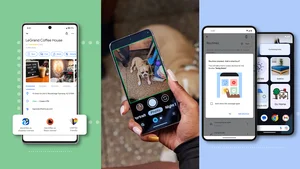Five insights on voice technology
Over the last couple years something interesting happened—millions of people began having conversations with their speakers, cars, computers and phones. Voice technology is fundamentally changing the way we use we our devices, often in ways we didn’t expect.
We’ve learned a lot about how we can better serve people’s needs with voice, helping them save time and get things done. Here are a few things we’ve learned since we introduced the Google Assistant nearly two years ago.
Voice is about action.
When people talk to their Google Assistant, they’re usually trying to get something done. Assistant queries are 40 times more likely to be action-oriented than Search, with people asking for things like “send a text message,” “turn off the lights,” or “turn on airplane mode.”
Why do we think this is happening? For many tasks, particularly while you’re on the go, it can be much easier to get things done through voice. I can say “turn on the lights and play some music,” without having to worry about which app I need to open. Even for basic things like creating a calendar invite, I don’t have to look down at my phone or interrupt what I’m doing, I can just say “create an appointment for noon on Saturday.” These seem like small things, and they are. But they illustrate what makes voice so unique—the technology allows me to complete a task in a way that feels natural. The more we can build these types of experiences, the closer we get to an ideal Assistant.
People expect conversations.
When people start using voice assistants, we often see very simple commands. But very quickly, expectations go up in terms of complex dialogue. We might see “weather Chicago” typed in Search, whereas with the Assistant we see much longer and more conversational queries like “what’s the weather today in Chicago at 3pm.” On average, Assistant queries are 200 times more conversational than Search.
We’ve seen that even simple commands can take all forms. For example, people ask the Google Assistant to set an alarm in more than 5,000 different ways, which means that we have to build the Assistant to understand this conversational complexity.

Screens change everything.
The world hasn’t completely shifted to voice, nor do we expect it to. Screens bring a completely new canvas for conversational AI, where we can bring together voice and touch in an intelligent way. So when you ask for a pasta dough recipe, you can get visuals of what the dough should look like while the Assistant reads you the steps along the way.
With the launch of Smart Displays and our new visual experience for phones, we’ve evolved the Google Assistant to become much more dynamic, spanning voice, screens, tapping and typing. And we’re seeing people respond—in fact, nearly half of interactions with Assistant today include both voice and touch input.
Daily routines matter.
You can access the Assistant almost anywhere you are throughout the day—on the phone, in the car, or on a speaker in the living room. So it makes sense that when people use the Assistant, it’s largely driven by their environment and what they’re trying to accomplish in their daily routines.
Let’s take a look at some of the most popular ways we use the Google Assistant in our daily routines. In the morning, we’ll use our smart speakers to ask for the weather or listen to the news. During lunch and on the commute home, we’ll text and call our friends, or look for local restaurants. When we get home, we want to listen to music. And at the end of the day, we get ready for tomorrow with tasks like “set an alarm,” “set a reminder,” or “ask the Assistant to tell me about tomorrow’s meetings.” Where and how we use our Assistant varies throughout the day, but the consistency of the experience should stay the same.

Voice is universal.
One of the most exciting things to witness about digital assistants is that even though the Assistant is a new technology, it’s incredibly easy to adopt. There’s no user manual needed, and people of all ages, across all types of devices, and in many different geographies can use the Assistant. Because of this, we’re finding that Google Assistant users defy the early adopter stereotype—there’s a huge uptick in seniors and families, and women are the fastest growing user segment for the Assistant.
Voice is also universal on a global scale. Over the past year, we've brought the Assistant to more countries and languages. In places where people are coming online for the first time—like India, where Google Assistant usage has tripled in India since the beginning of the year—voice is taking the forefront as the primary way they interact with their devices.
Of course voice technology is still relatively new and evolving. We’re just figuring out what works in this space. But it’s exciting to see how voice technology is making it easier for people to get things done, and we’re all learning together.






